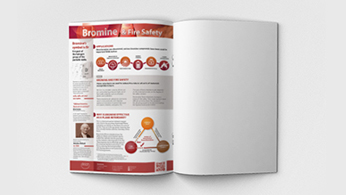Modern home and public spaces contain highly flammable materials. While the increased use of plastics, composites, foams and synthetic fiber-based fillings has transformed our spaces into practical, comfortable and more energy efficient living, it has brought with it an increased risk of fire as many of these polymers can be highly flammable. Upholstered furniture, carpets, wall coverings and drapery can easily ignite and burn rapidly if not adequately protected and compliant with high fire safety standards.

Fire Safety
Bromine based flame retardants are substances that inhibit or slow down the growth of a fire

Measures which prolong escape time, such as introducing fire safe furniture, ensure that fewer people are killed or injured in fires. Flame retardants are an effective element to protect people from fires.
In order to effectively reduce fires and their detrimental effects, it is crucial to put in place regulations and standards[2] that ensure a good level of protection from fires. Better fire safety can only be achieved when 3 key elements are taken into account:
- passive resistance of materials (e.g. flame-retardant materials, fire doors, fire walls)
- early detection of fire (e.g. smoke and/or fire alarm systems)
- active suppression of fire (e.g. fire extinguishers, sprinkler systems and standpipes)
Action has been taken at an European level in order to ensure that harmonised fire safety standards are in place across Europe to ensure the same level of consumer protection. The manufacturers of brominated flame retardants are also responding continuously to customer and societal trends for more sustainable fire safety technologies.
Flame Retardants
There are more than 200 different types of flame retardants, which producers classify according to their major constituent elements. The elements determine their chemical reaction with fire and therefore their suitability in different applications.
Bromine & Flame Retardants
Bromine is very efficient as a constituent element, which means that only a small amount is needed to achieve fire resistance. Brominated flame retardants consist of more than 70 different chemical substances with different properties, they are used for electrical and electronic equipment such as televisions, computers, radios, fridges and washing machines. They are also used in furniture, automotive, transport and building and construction applications.
The Fire Load
Modern homes and public spaces contain highly flammable materials. While the increased use of plastics, composites, foams and synthetic fibre-based fillings has transformed our spaces into practical, comfortable and more energy efficient living, it has brought with it an increased risk of fire as many of these polymers can be highly flammable. Upholstered furniture, carpets, wall coverings and drapery can easily ignite or burn rapidly if not adequately protected and compliant with high fire safety standards.
What are Flame Retardants?
The term “flame retardant” describes a function of chemicals. There are more than 200 different types of flame-retardants, which producers classify according to the major chemical constituent elements.
The elements determine their chemical reaction with fire and therefore their suitability in different applications.
The substances used on flame retardants include phosphorous, bromine, nitrogen, metal hydroxides and oxides as well as chlorine.
Though these different “families” are widely used to classify flame-retardants in a simple way, there is a great deal of overlap between them.
Certain compounds show strong synergy across the families and are used in combinations, such as those containing chlorine and phosphorous or nitrogen and phosphorous.
Primary benefits of brominated flame-retardants in foam insulation:
Reduced likehood of ignition
Lower % by mass of flame retardant
Reduced heat release
Slower fire growth
How Flame Retardants Work
Measures which prolong escape time, such as introducing fire safe furniture, ensure that fewer people are killed or injured in fires. Flame retardants are an effective element to protect people from fires. They can significantly delay ignition in the early stages of a fire when it can still be extinguished, or occupants of a building can escape.
- Disrupt the combustion stage of a fire cycle including avoiding or delaying “flashover,” or the burst of flames that engulfs a room and makes it much more difficult to escape.
- Limit the process of decomposition by physically insulating the available fuel sources from the material source with a fire-resisting “char” layer.
- Dilute the flammable gases and oxygen concentrations in the flame formation zone by emitting water, nitrogen or other inert gases.
 BUILDING AND PUBLIC SPACES
BUILDING AND PUBLIC SPACES
From houses to office buildings to clubs or theatres, modern buildings are more comfortable than ever thanks to modern materials such as plastics and insulation foams, which are unfortunately also highly flammable. In cinemas and theatres, comfortable chairs use materials such as polyurethane foam. Flame retardants help assure safety even in crowded places with a high concentration of such materials.
Insulation foams are in the walls and roofs of our buildings, contributing to critical energy savings. Like the foams used in upholstered furniture, building insulation foams also carry the risk of being highly flammable, hence the need to make them flame-retarded.
 HOMES
HOMES
Modern homes contain highly flammable materials – not only in furniture, but increasingly in electronics. Printed circuit boards are essential for most modern electronics. Plastics used in them have to resist heat generated by the circuit board to be safe and reliable. The reliability of printed circuit boards using brominated flame retardants has been demonstrated in more than 20 years of use. Brominated flame retardants are also used in furniture. Statistics show that lethal domestic fires frequently start either in beds or on sofas. This is why fire resistant fillings and textiles in furniture and bedding are essential.
 TRANSPORT
TRANSPORT
BFRs make sure that innovative materials used in modern transport can be used safely and meet strict international fire safety standards.
Airplanes carry a large amount of fuel and the cabin contains plastics, polymers and composites. In ground accidents, flame retardants help ensure passengers can get out of the damaged airplane safe. Flame retardants were commended for saving lives after the 2013 Asiana Airline crash in San Francisco, as well as after the 2005 crash of a passenger jet in Toronto, in which all 309 people aboard survived. Brominated are also used in trains where curtains, seat covers and fillings, as well as vertical and horizontal panelling all need to be fire safe. Finally, materials used in cars are subject to a huge amount of daily thermal stress, which makes their use practically inconceivable without the application of flame retardants.
End of life of products containing brominated flame retardants1
Products with brominated flame retardants can undergo a number of waste management options at the end of their life. The choice depends on the amount and composition of the waste stream as well as on local conditions.
For many years, recycling of products containing brominated flame retardants has been possible and delivers very satisfying results2. Plastics with brominated flame retardants can have excellent stability during recycling which allows recycled plastics to meet the same levels of fire safety as virgin material. This maintains the value provided by flame retardants in the recycled plastic. Such activity represents a key opportunity to create jobs in the recycling sector and to encourage the transition towards a sustainable economy. When recycling is not possible, a range of eco-efficient waste management options are possible, such as incineration with energy recovery, precious metal smelting, as well as chemical recycling leading to the recovery of bromine which allows the re-entry of this valuable resource into the circular economy. The brominated flame retardant industry is committed to working closely with authorities, the value chain and other stakeholders to further encourage sustainable end of life solutions.
Did you know?
References
1. [1] European Environment Agency, Earnings, jobs and innovation: the role of recycling in a green economy (EEA Report No 8/2011) and http://www.epa.gov/osw/conserve/tools/localgov/benefits/ (viewed August 2012)
[2] Boerrigter, H., “Implementation of thermal processes for feedstock recycling of bromine and antimony, with energy recovery, from plastics waste of electrical and electronic Equipment, Phase 1”, Netherlands Energy Research Foundation (ECN), July 2000.
[3] Umicore study: 2006 Using Plastic-Metal Rich Mixed Weee Materials As Feedstock /Fuelsubstitute For A Metals Smelter
[4] TBBPA’s EU Risk Assessment and Mark, F.E., (Dow Europe), Lehner, T.,Plastic Recovery from Waste Electrical and Electronic Equipment in Non-Ferrous Metal Processes 2000.
[5] Implementation of thermal processes for feedstock recycling of bromine and antimony, with energy recovery, from plastics waste of electrical and electronic Equipment, Phase 1″ Dr H. Boerrigter, ECN, July 2000
[6]Takashi Yamawaki, The gasification recycling technology of plastics WEEE containing brominated flame retardants, 2003
[7] E&HS aspects on metal recovery from electronic scrap”. Sweden, Metal and Energy Recovery Conference. Lehner T., Boliden (2003).
[8] Borgnes and Rikheim, Emission measurement during incineration of waste containing Bromine, Kjelforenigne Norsk Energi, 2005
2. Imai T., S. Hamm, K.P. Rothenbacher, Techno Polymer Co., Ltd “Comparison of the recyclability of flame-retarded plastics”; Environ Sci Technol. Feb 1;37(3):652-6;., 100 Kawajiri-cho, Yokkaichi, Mie 510-0871, Japan, 2003



